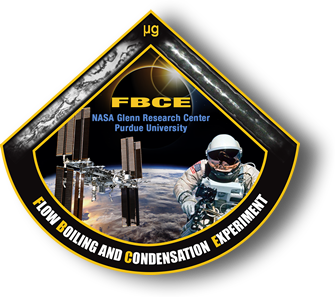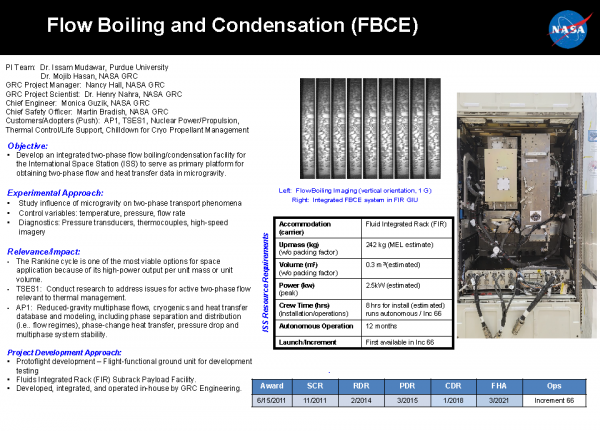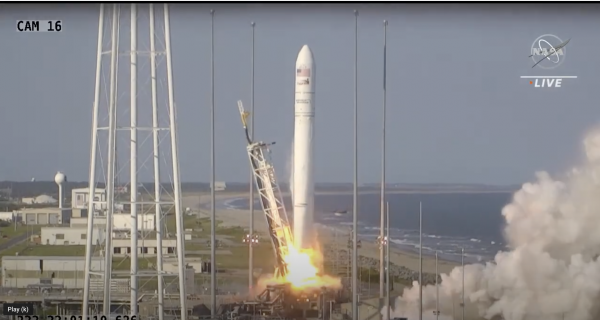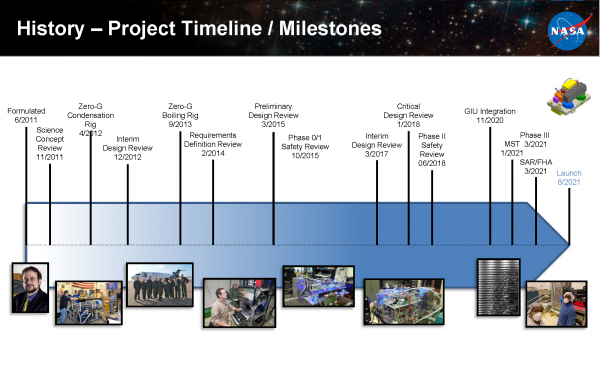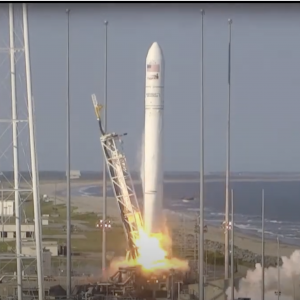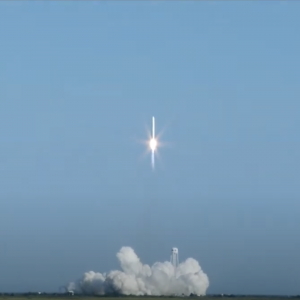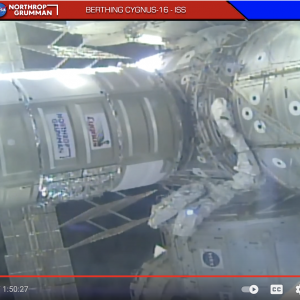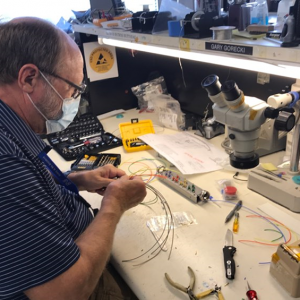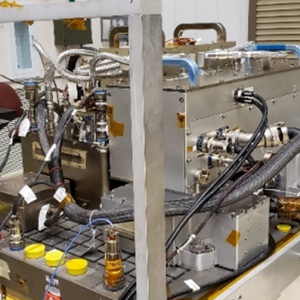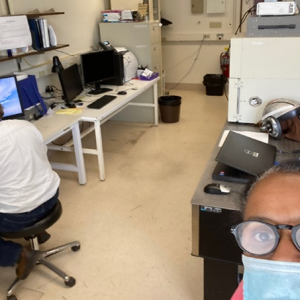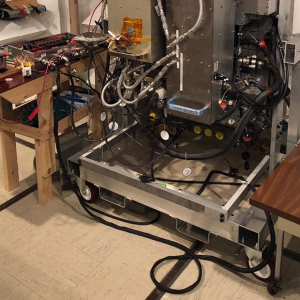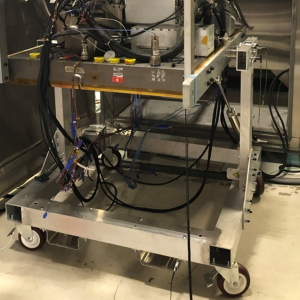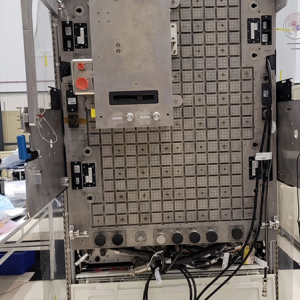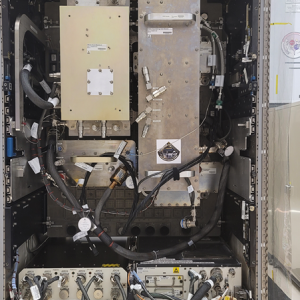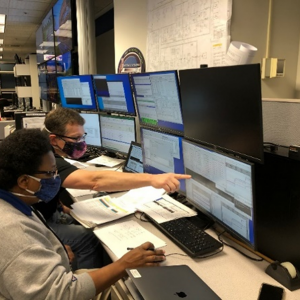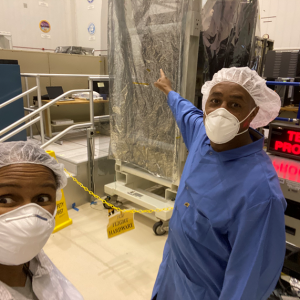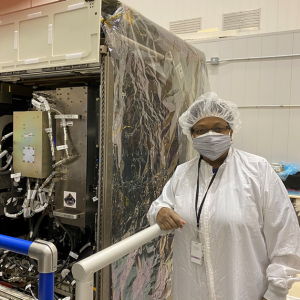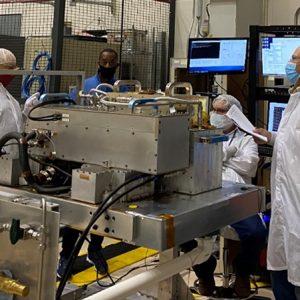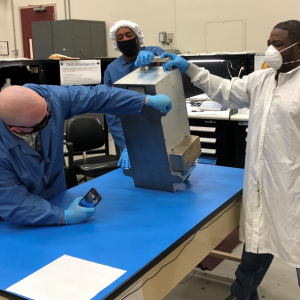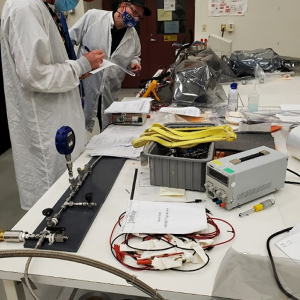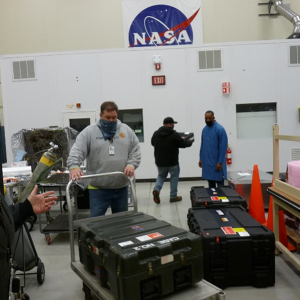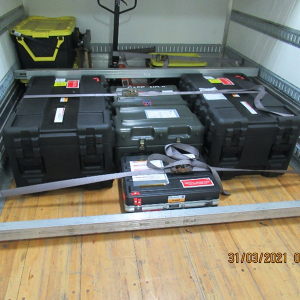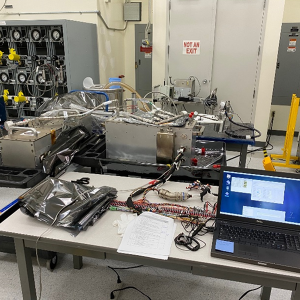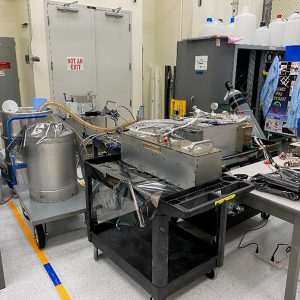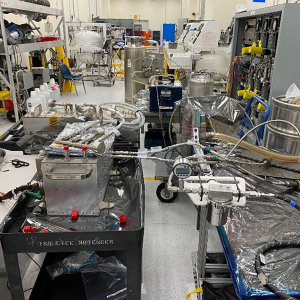Flow Boiling and Condensation Experiment (FBCE)
Flow Boiling and Condensation Experiment (FBCE)
The proposed research aims to develop an integrated two-phase flow boiling/condensation facility for the International Space Station (ISS) to serve as a primary platform for obtaining two-phase flow and heat transfer data in microgravity. By comparing the microgravity data against those obtained in Earth’s gravity, it will be possible to ascertain the influence of body force on two-phase transport phenomena in pursuit of mechanistic models as well as correlations, and to help determine the minimum flow criteria to ensure gravity independent flow boiling and condensation. This research will be a joint effort between the Purdue University Boiling and Two-Phase Flow Laboratory (BTPFL) and the NASA Glenn Research Center. Personnel from the two organizations combine extensive experience in research and development of both flow boiling and condensation systems, and in conducting microgravity experiments.
FBCE Status
Checkout of the FBCE hardware occurred during 8 checkout days between January and February and went well. FBCE science operations began on Feb 22, 2022 and is ongoing. Operations is schedule to last 6 months with 187 test points planned during that time frame. Currently the operation cadence is 2 days of operation following by one day where data and images are downlinked.
On December 7, 2021, at 3:45AM EST, Astronaut Mark Vande Hei gathered hardware for FBCE configuration and installed the first part of FBCE into the Fluids Integration Rack (FIR). Activities included crew configuring the FIR for FBCE operations by translating out the Optics Bench, installing all FBCE hardware, translating in the Optics Bench without making connections, and buttoning up the rack doors until next access for Part 2. On December 9, 2021 at 10:00AM EST, Astronaut Mark Vande Hei continued the installation of the FBCE into the Fluids Integration Rack (FIR). Activities included the crew configuring the FIR or FBCE operations by reopening FIR and translating out the Optics Bench from Part 1, installing the remainder of FBCE hardware and translating in the Optics Bench back into the rack.
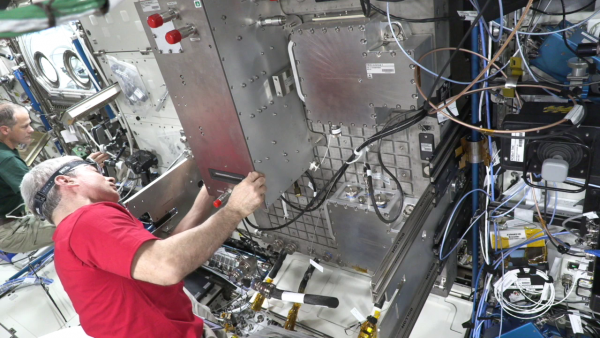
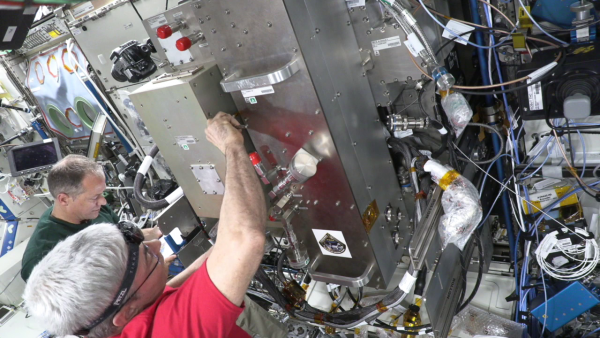
Mission Sequence Testing (MST) for FBCE ran 13 days between Jan and Feb 2021 in between GIU operations. The MST is used to simulate 47 science test points and flight operating procedures. During MST, 47 of 48 science test points were run. In addition, the flight operating procedures for startup and shutdown, software updates, initial on-orbit checkout, test point operations, file maintenance, off-nominal and auxiliary procedures were identified and/or developed during integrated GIU operations. 46 of 47 science test runs were executed successfully from a hardware and science standpoint. The hardware verified to be capable of running different ranges in operating conditions and different inlet conditions The project scientist commented, “If hardware performs similarly during science operation on ISS, it is expected we meet high degree of success”
FBCE was installed into the Fluids Integrated Rack (FIR) Ground Integration Unit starting in November 2020. Following GIU Integration, FBCE conducted a series of System Verification and Validations testing in the GIU. Training for FBCE Qualified Operators were also conducted during and after System V&V testing.
FBCE conducted an Integrated GIU Debrief are to summarize accomplishments, lessons learned, and identify open action items and action item owners for integrated FCF FBCE GIU activities from hardware integration through hardware de-integration. This will result in the development and improvement of products and processes and help lead the team to successful flight integration and operations. The GIU Debrief showed the FBCE team issues and anomalies that were prevalent in the FBCE system.
FBCE conducted a Phase II Safety Review. The Safety review assesses the safety of the Flow Boiling and Condensation Experiment (FBCE) hardware, on-orbit integration into the Fluids and Combustion Facility (FCF) Fluids Integrated Rack (FIR), on-orbit FBCE operations, and return based on the design presented at the FBCE Critical Design Review.
FBCE held a Critical Design Review (CDR) which demonstrates that the maturity of the design is appropriate to support proceeding with full-scale fabrication, assembly, integration, and test; that the technical effort is on track to complete the flight and ground system development; and mission operations to meet mission performance requirements within the identified cost and schedule constraints. The engineering panel commented that “Significant improvement since the IDR, can’t underestimate the progress the project has made. Most subsystems/teams were in excellent shape and ready to proceed.”
FBCE held an Internal Design Review (IDR) to demonstrate that the project leads had a full understanding of the requirement compliance and associated products in preparation for developing the schedule to Critical Design Review (CDR) and Flight Hardware Available (FHA).
FBCE conducted a Phase 0/1 Safety Review. The Safety review assesses the safety of the Flow Boiling and Condensation Experiment (FBCE) hardware, on-orbit integration into the Fluids and Combustion Facility (FCF) Fluids Integrated Rack (FIR), on-orbit FBCE operations, and return based on the preliminary design.
FBCE held a Preliminary Design Review (PDR) which is a non-advocate review held to demonstrate that the preliminary design of an experiment meets all system requirements with acceptable risk and within the cost and schedule constraints. It also establishes the basis for proceeding with a detailed design. The engineering panel commented that “The engineering and science teams have done an excellent job working together to develop a system to accomplish the FBCE goals. The information presented at the PDR show the teams have continued to proceed along an appropriate path towards flight and that the hardware complies with the engineering requirements.”
FBCE held its Requirements Definition Review (RDR) and it consisted of both a science panel and engineering panel. The RDR Science Panel re-affirmed that FBCE has substantial value to the multiphase heat transfer community. They also stated that “Extensive ground and parabolic flight testing have been completed that validate the experimental concept. The project is sufficiently mature to move forward toward space deployment.” Similarly, the two technology advisors affirmed that FBCE “is necessary for gathering multiphase data critical to the development of thermal control and power technology for larger and longer duration space missions..” The engineering panel commented that “The science and engineering teams have done an excellent job in defining and conducting the ground experiments, and providing confidence in the overall design approach for the ISS experiments.”
Two aircraft rigs that supported FBCE flew during the GRC aircraft flight campaign the week of Sept 17 at Ellington Field in Houston, TX. Reduced Gravity Aircraft Testing was conducted by GRC personnel using GRC’s Flow Boiling Module (FBM) Rig. The FBM rig was tested and showed excellent performance in repeatability in vapor production. The Carthage College “Degassing FC-72 in Microgravity” aircraft rig was given the opportunity to fly again. The central objective for the FC-72 de-gassing experiment was to provide comparative data for filtration efficiency of a radial membrane contactor in reduced gravity for use in de-gassing liquid FC-72.
FBCE held an Informal Design Review whose purpose was to present the current status of the design to an engineering panel and to get an assessment of the state of the FBCE design in meeting the science requirements for the Requirements Definition Review (RDR). Numerous comments were made by the panel members covering the fluid system, thermal, avionics, software and imaging which the FBCE team will incorporate as they progress with the hardware testing and build.
The Purdue University Zero-G Condensation Rig with Lytron cooling was operated during the flight campaign week of April 27 at Ellington Field in Houston, TX. Students from Purdue University as well as FBCE team members operated the rig during the ~161 parabolas, where condensation data were obtained and saved including 95 video files.
FBCE received its authority to proceed from NASA HQ following a successfully Science Requirements Review. The science panel commented that “the Flow Boiling and Condensation Experiment (FBCE) has substantial value to the multiphase heat transfer community, and there exists a compelling need to utilize the international space station for a high quality, long duration microgravity environment in order to meet the project scientific objectives.” The two technology advisors present during the review commented that FBCE “is maturing towards being a platform that will provide vital scientific validation for mechanistic models necessary for design of microgravity two-phase thermal and power systems” and “two-phase fluid transport systems offer much improved energy-to-mass ratios compared to single-phase system, but data and models for reduced gravity flow boiling and condensation are essentially non-existent”. These are areas where FBCE can make significant contributions.
The start of formulation for FBCE began with the FBCE project manager (PM), product lead engineer (PLE) and project scientist meeting with the FBCE Co-Investigator to get an overview of the FBCE experiment. The PM and PLE then worked together to identify discipline needs, timeline for milestones and products and identify PM products and due dates.
Objectives
- Obtain flow boiling database in a long-duration microgravity environment
- Obtain flow condensation database in a long-duration microgravity environment
- Develop an experimentally validated, mechanistic model for microgravity flow boiling critical heat flux (CHF) and dimensionless criteria to predict minimum flow velocity required to ensure gravity-independent CHF
- Develop an experimentally validated, mechanistic model for microgravity annular condensation and dimensionless criteria to predict minimum flow velocity required to ensure gravity-independent annular condensation; also develop correlations for other condensation regimes in microgravity
Relevance/Impact
- Reduced gravity condensation and flow boiling heat transfer data and models are virtually nonexistent.
- Long-duration space missions will demand additional power and heat dissipation requirements compared to current space missions. To reduce size and weight, the transition from single-phase to two-phase thermal management systems is necessary.
- In addition, two-phase thermal management systems are more effective heat transfer systems compared to single-phase systems because two-phase systems rely on latent heat exchange rather than sensible heat exchange.
- Flow boiling and condensation data in microgravity are also needed to validate numerical simulation tools that could be used to design space-based two-phase thermal management systems.
Development Approach
- Develop two-phase flow loop to condition normal perfluorohexane (C6F14), or nPFH to preset values of flow rate, pressure, and temperature to the test module
- Develop Flow Boiling Module (FBM) to study subcooled and saturated flow boiling and critical heat flux (CHF)
- Develop two separate Condensation Modules to enable study of condensation flow and heat transfer regimes: Condensation Module for heat transfer (CM-HT) measurements and Condensation Module for flow visualization (CM-FV).
Image Gallery
Publications
- Kharangate, C.R. and Mudawar, I. and Hasan, M.H., 2012, “Experimental and Theoretical Study of Critical Heat Flux in Vertical Upflow with Inlet Vapor Void,” International Journal of Heat and Mass Transfer, Vol. 55, pp. 360-374.
- Kim, S.M. and Mudawar, I., 2012, “Theoretical Model for Annular Flow Condensation in Rectangular Micro-Channels,” International Journal of Heat and Mass Transfer, Vol. 55, pp. 958-970.
- Kim, S.M. and Mudawar, I., 2012, “Universal Approach to Predicting Two-Phase Frictional Pressure Drop for Adiabatic and Condensing Mini/Micro-Channel Flows,” International Journal of Heat and Mass Transfer, Vol. 55, pp. 3246-3261.
- Kharangate, C.R. and Mudawar, I. and Hasan, M.H., 2012, “Photographic Study and Modeling of Critical Heat Flux in Horizontal Flow Boiling with Inlet Vapor Void,” International Journal of Heat and Mass Transfer, Vol. 55, pp. 4154-4168.
- Kim, S.M. and Mudawar, I., 2013, “Universal Approach to Predicting Heat Transfer Coefficient for Condensing Mini/Micro-Channel Flows,” International Journal of Heat and Mass Transfer, Vol. 56, pp. 238-250.
- Park, I., Kim, S.M. and Mudawar, I., 2013, “Experimental Measurement and Modeling of Downflow Condensation in a Circular Tube,” International Journal of Heat and Mass Transfer, Vol. 57, pp. 567-581.
- Kim, S.M. and Mudawar, I., 2013, “Universal Approach to Predicting Two-Phase Frictional Pressure Drop for Mini/Micro-Channel Saturated Flow Boiling,” International Journal of Heat and Mass Transfer, Vol. 58, pp. 718-734.
- Konishi, C., Mudawar, I. and Hasan, M.M., 2013, “Investigation of the Influence of Orientation on Critical Heat Flux for Flow Boiling with Two-Phase Inlet,” International Journal of Heat and Mass Transfer, Vol. 61, pp. 176-190.
- Lee, H., Mudawar, I. and Hasan, M.M., 2013, “Experimental and Theoretical Investigation of Annular Flow Condensation in Microgravity,” International Journal of Heat and Mass Transfer, Vol. 61, pp. 293-309.
- Mascarenhas, N. and Mudawar, I. 2013, “Investigation of Eddy Diffusivity and Heat Transfer Coefficient for Free-Falling Turbulent Liquid Films Subjected to Sensible Heating,” International Journal of Heat and Mass Transfer, Vol. 64, pp. 647-660.
- Kim, S.M. and Mudawar, I., 2013, “Universal Approach to Predicting Saturated Flow Boiling Heat Transfer in Mini/Micro-Channels Part I. Dryout Incipience Quality,” International Journal of Heat and Mass Transfer, Vol. 64, pp. 1226-1238.
- Kim, S.M. and Mudawar, I., 2013, “Universal Approach to Predicting Saturated Flow Boiling Heat Transfer in Mini/Micro-Channels Part II. Two-Phase Heat Transfer Coefficient,” International Journal of Heat and Mass Transfer, Vol. 64, pp. 1239-1256.
- Park, I. and Mudawar, I., 2013, “Climbing Film, Flooding and Falling Film Behavior in Upflow Condensation in Tubes,” International Journal of Heat and Mass Transfer, Vol. 65, pp. 44-61.
- Konishi, C., Mudawar, I. and Hasan, M.M., 2013, “Criteria for Negating the Influence of Gravity on Flow Boiling Critical Heat Flux with Two-Phase Inlet Conditions,” International Journal of Heat and Mass Transfer, Vol. 65, pp. 203-218.
- Lee, H. and Mudawar, I., and Hasan, M.M., 2013, “Flow Condensation in Horizontal Tubes,” International Journal of Heat and Mass Transfer, Vol. 66, pp. 31-45.
- Konishi, C., Mudawar, I. and Hasan, M.M., 2013, “Investigation of Localized Dryout versus CHF in Saturated Flow Boiling,” International Journal of Heat and Mass Transfer, Vol. 67, pp. 131-146.
- Mascarenhas, N. and Mudawar, I., 2013, “Study of the Influence of Interfacial Waves on Heat Transfer in Turbulent Falling Films,” International Journal of Heat and Mass Transfer, Vol. 67, pp. 1106-1121.
- Lee, H., Park, I., Konishi, C., Mudawar, I., May, R.I., Juergens, J.R., Wagner, J.D., Hall, N.R., Nahra, H.K., Hasan, M. and Jeffrey R. Mackey, J.R., 2014, “Experimental Investigation of Flow Condensation in Microgravity,” Journal of Heat Transfer, Vol. 136, 021701.
- Mascarenhas, N. and Mudawar, I., 2014, “Statistical Analysis of Measured and Computed Thickness and Interfacial Temperature of Free-Falling Turbulent Liquid Films,” International Journal of Heat and Mass Transfer, Vol. 73, pp. 716-730.
- Kim, S.M. and Mudawar, I., 2014, “Theoretical Model for Local Heat Transfer Coefficient for Annular Flow Boiling in Circular Mini/Micro-Channels,” International Journal of Heat and Mass Transfer, Vol. 73, pp. 731-742.
- Kim, S.M. and Mudawar, I., 2014, “Review of Databases and Predictive Methods for Pressure Drop in Adiabatic, Condensing and Boiling Mini/Micro-Channel Flows,” International Journal of Heat and Mass Transfer, Vol. 77, pp. 74-97.
- Kim, S.M. and Mudawar, I., 2014, “Review of Databases and Predictive Methods for Heat Transfer in Condensing and Boiling Mini/Micro-Channel Flows,” International Journal of Heat and Mass Transfer, Vol. 77, pp. 627-652.
- Lee, H., Park I., Mudawar, I. and Hasan M.M., 2014, “Micro-Channel Evaporator for Space Applications – 1. Experimental Pressure Drop and Heat Transfer Results for Different Orientations in Earth Gravity,” International Journal of Heat and Mass Transfer, Vol. 77, pp. 1213-1230.
- Lee H., Park I., Mudawar, I. and Hasan M.M., 2014, “Micro-Channel Evaporator for Space Applications – 2. Assessment of Predictive Tools,” International Journal of Heat and Mass Transfer, Vol. 77, pp. 1231-1249.
- Konishi, C., Mudawar, I., 2015, “Review of Flow Boiling and Critical Heat Flux in Microgravity,” International Journal of Heat and Mass Transfer, Vol. 80, pp. 469-493.
- Park I., Lee H. and Mudawar, I., 2015, “Determination of Flow Regimes and Heat Transfer Coefficient for Condensation in Horizontal Tubes,” International Journal of Heat and Mass Transfer, Vol. 80, pp. 698-716.
- Kharangate, C., Lee, H., and Mudawar, I., 2015, “Computational Modeling of Turbulent Evaporating Falling Film,” International Journal of Heat and Mass Transfer, Vol. 81, pp. 52-62.
- Konishi, C., Lee, H., Mudawar, I., Hasan, M.M., Nahra, H.K., Hall, N.R., Wagner, J.D., May, R.L., and Mackaey, J.R., 2015, “Flow Boiling in Microgravity: Part 1 – Interfacial Behavior and Experimental Heat Transfer Results,” International Journal of Heat and Mass Transfer, Vol. 81, pp. 705-720.
- Konishi, C., Lee, H., Mudawar, I., Hasan, M.M., Nahra, H.K., Hall, N.R., Wagner, J.D., May, R.L., and Mackaey, J.R., 2015, “Flow Boiling in Microgravity: Part 2 – Critical Heat Flux Interfacial Behavior, Experimental Data, and Model,” International Journal of Heat and Mass Transfer, Vol. 81, pp. 721-736.
- Mascarenhas, N., Lee H. and Mudawar, I., 2015, “Experimental and Computational Investigation of Interfacial Shear along Wavy Two-Phase Interfaces,” International Journal of Heat and Mass Transfer, Vol. 85, pp. 265-280.
- Lee, H., Kharangate, C.R., Mascarenhas, N., Park I., and Mudawar, I., 2015, “Experimental and Computational Investigation of Vertical Downflow Condensation,” International Journal of Heat and Mass Transfer, Vol. 85, pp. 865-879.
- Kim, S.M, Mudawar, I., 2015, “Review of Two-Phase Critical Flow Models and Investigation of the Relationship between Choking, Premature CHF, and CHF in Micro-Channel Heat Sinks,” International Journal of Heat and Mass Transfer, Vol. 87, pp. 497-511.
- Kharangate, C.R., O’Neill, L.E., Mudawar, I., Hasan, M.M., Nahra, H.K., Ramaswamy, B., Hall, N.R., Macner, A.M., and Mackey, J.R., 2015, “Flow Boiling and Critical Heat Flux in Horizontal Channel with One-sided and Double-sided Heating,” International Journal of Heat and Mass Transfer, Vol. 90, pp. 323-338.
- Kharangate, C.R., O’Neill, L.E., Mudawar, I., Hasan, M.M., Nahra, H.K., Ramaswamy, B., Hall, N.R., Macner, A.M., and Mackey, J.R., 2015, “Effects of Subcooling and Two-Phase Inlet on Flow Boiling Heat Transfer and Critical Heat Flux in a Horizontal Channel with One-sided and Double-sided Heating,” International Journal of Heat and Mass Transfer, Vol. 91, pp. 1187-1205.
- Kharangate, C.R., Konishi, C., and Mudawar, I., 2016, “Consolidated Methodology to Predicting Flow Boiling Critical Heat Flux for Inclined Channels in Earth Gravity and for Microgravity,” International Journal of Heat and Mass Transfer, Vol. 92, pp. 467-482.
- Kharangate, C.R., Lee, H., Park I., and Mudawar, I., 2016, “Experimental and Computational Investigation of Vertical Upflow Condensation in a Circular Tube,” International Journal of Heat and Mass Transfer, Vol. 95, pp. 249-263.
- O’Neill, L.E., Kharangate, C.R., and Mudawar, I., 2016, “Time-averaged and Transient Pressure Drop for Flow Boiling with Saturated Inlet Conditions,” International Journal of Heat and Mass Transfer, Vol. 103, pp. 133-153.
- Kharangate, C.R., O’Neill, L.E., and Mudawar, I., 2016, “Effects of Two-Phase Inlet Quality, Mass Velocity, Flow Orientation, and Heating Perimeter on Flow Boiling in a Rectangular Channel: Part 1 – Two-Phase Flow and Heat Transfer Results,” International Journal of Heat and Mass Transfer, Vol. 103, pp. 1261-1279.
- Kharangate, C.R., O’Neill, L.E., and Mudawar, I., 2016, “Effects of Two-Phase Inlet Quality, Mass Velocity, Flow Orientation, and Heating Perimeter on Flow Boiling in a Rectangular Channel: Part 2 – CHF Experimental Results and Model,” International Journal of Heat and Mass Transfer, Vol. 103, pp. 1280-1296.
- Park, I., O’Neill, L.E., and Mudawar, I., 2017, “Assessment of Body Force Effects in Flow Condensation, Part I: Experimental Investigation of Liquid Film Behavior for Different Orientations,” International Journal of Heat and Mass Transfer, Vol. 106, pp. 295-312.
- O’Neill, L.E., Park, I., Chirag R. Kharangate, C.R., V.S., Devahdhanush, Ganesan, V., and Mudawar, I., 2017, “Assessment of Body Force Effects in Flow Condensation, Part II: Criteria for Negating Influence of Gravity,” International Journal of Heat and Mass Transfer, Vol. 106, pp. 313-328.
- Kim, S.M and Mudawar, I., 2017, “Thermal Design and Operational Limits of Two-Phase Micro-channel Heat Sinks,” International Journal of Heat and Mass Transfer, Vol. 106, pp. 861-876.
- Kharangate, C.R. and Mudawar, I., 2017, “Review of Computational Studies on Boiling and Condensation,” International Journal of Heat and Mass Transfer, Vol. 108, pp. 1164-1196.
- Mudawar, I., 2017, “Flow Boiling and Flow Condensation in Reduced Gravity,” Advances in Heat Transfer, Vol. 49, pp. 225-306.
- O’Neill, L.E., Mudawar, I., Hasan, M.M., Nahra, H.K., Ramaswamy, B., Hall, N.R., Lokey, and Mackey, J.R., 2018, “Experimental Investigation into the Impact of Density Wave Oscillations on Flow Boiling System Dynamic Behavior and Stability,” International Journal of Heat and Mass Transfer, Vol. 120, pp 144-166.
- O’Neill, L.E., and Mudawar, I., 2018, “Mechanistic Model to Predict Frequency and Amplitude of Density Wave Oscillations in Vertical Upflow Boiling,” International Journal of Heat and Mass Transfer, Vol. 123, pp. 143-171.
- O’Neill, L.E., Mudawar, I., Hasan, M.M., Nahra, H.K., Ramaswamy, and Mackey, J.R., 2018, “Experimental Investigation of Frequency and Amplitude of Density Wave Oscillations in Vertical Upflow Boiling,” International Journal of Heat and Mass Transfer, Vol. 125, pp. 1240-1263.
- O’Neill, L.E., Mudawar, I., Hasan, M.M., Nahra, H.K., Ramaswamy, and Mackey, J.R., 2018, “Flow Condensation Pressure Oscillations at Different Orientations,” International Journal of Heat and Mass Transfer, Vol. 127, pp. 784-809.
- Lee, S. and Mudawar, I., 2019, “Enhanced Model for Annular Flow in Micro-channel Heat Sinks, including effects of Droplet Entrainment/Deposition and Core Turbulence,” International Journal of Heat and Mass Transfer, Vol. 133, pp. 510-530.
- O’Neill, L.E., Ramaswamy, R., Nahra, H.K., Hasan, M.M., Mackey, J.R., and Mudawar, I., 2019, “Identification of Condensation Flow Regime at different Orientations using Temperature and Pressure Measurements,” International Journal of Heat and Mass Transfer, Vol. 135, pp. 569-590.
- Lee, J., O’Neill, L.E., Lee,, and Mudawar, I., 2019, “Experimental and Computational Investigation on Two-Phase Flow and Heat Transfer of Highly Subcooled Flow Boiling in Vertical Upflow,” International Journal of Heat and Mass Transfer, Vol. 136, pp. 1199-1216.
- O’Neill, L.E., Ramaswamy, R., Nahra, H.K., Hasan, M.M., and Mudawar, I., 2019, “Flow condensation heat transfer in a smooth tube at different orientations: Experimental results and predictive models,” International Journal of Heat and Mass Transfer, Vol. 140, pp. 533-563.
- Lee, J., O’Neill, L.E., and Mudawar, I., 2020, “3-D Computational Investigation and Experimental Validation of Effect of Shear-Lift on Two-Phase Flow and Heat Transfer Characteristics of Highly Subcooled Flow Boiling in Vertical Upflow,” International Journal of Heat and Mass Transfer, Vol. 150, 119291.
- O’Neill, L.E. and Mudawar, I., 2020, “Review of Two-phase Instabilities in Macro- and Micro-channel Systems,” International Journal of Heat and Mass Transfer, Vol. 157, 119738.
- Lee, J., O’Neill, L.E., and Mudawar, I., 2020, “Computational prediction of key heat transfer mechanisms and hydrodynamic characteristics of critical heat flux (CHF) in subcooled vertical upflow boiling,” International Journal of Heat and Mass Transfer, Vol. 161, 120262.
Project Management
Project Manager: Nancy Rabel Hall, NASA GRC
nancy.r.hall@nasa.gov
216-385-6302
Project Scientist: Henry Nahra, NASA GRC
henry.k.nahra@nasa.gov
216-433-5385
Principal Investigator: Issam Mudawar, Purdue University
Co-Principal Investigator: Mohammad Mojibul Hasan, NASA GRC
mohammad.m.hasan@nasa.gov
216-977-7494
Engineering Team: GRC Engineering

